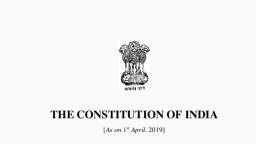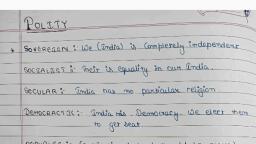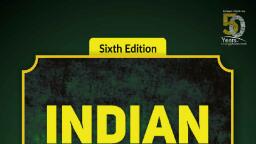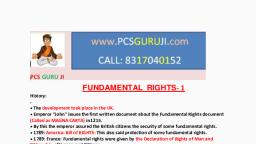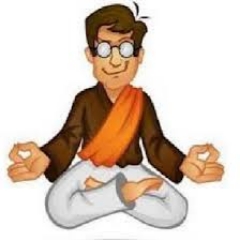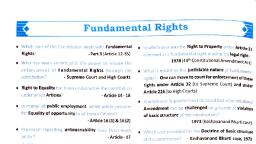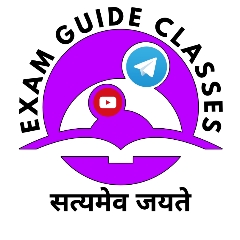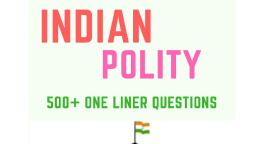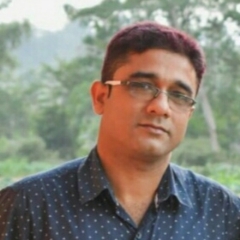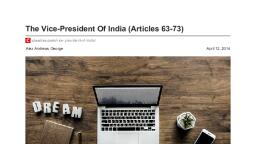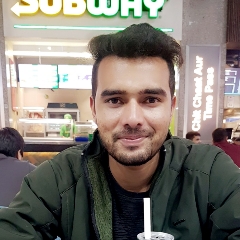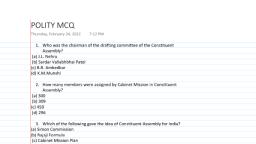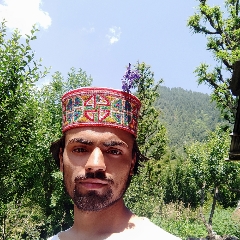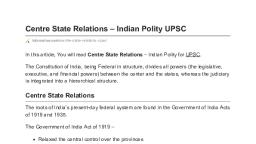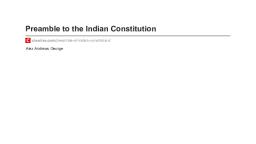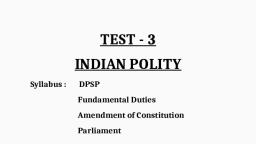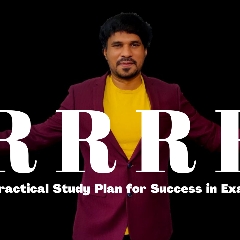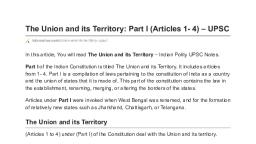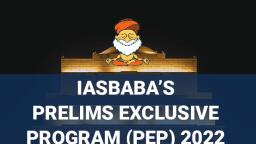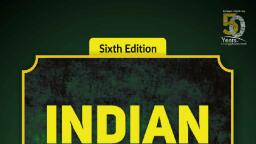Page 1 :
Short Notes of Indian Polity for State, Subordinate Exams, These notes will help the aspirants in a quick revision of Indian Polity for State, Subordinate Exams like UPSSSC, BSSC, DSSSB, Rajasthan Subordinate Services,, JSSC, OSSC etc., , Historical Evolution of Indian Constitution, The Company Administration, Regulating Act - 1773, (1) The post of 'GOVERNOR' was now made 'GOVERNOR-GENERAL' and Bengal was, the first province to have Warren Hastings as the first Governor-General. He was, assisted by an executive council of four members., (2) The Supreme Court at Calcutta was established with one chief justice and three, other judges. Sir Elijah Impey was the Chief Justice., Pitt’s India Act – 1784, (1) Created another body- ‘BOARD OF CONTROL’ to manage political affairs in India., COURT OF DIRECTORS kept on managing commercial affairs though., (2) Thus, companies’ possessions were for the first time called ‘British possessions in, India’ and the commercial wing was headed by the court of directors and political wing, headed by the board of control., (3) The Act was introduced by the then British Prime Minister William Pitt., Charter Act – 1813:
Page 2 :
(1) Ended the monopoly of the trading rights of British East India Company and, allowed other companies to participate in trading activities with India., Charter Act – 1833, (1) Created the post of ‘GOVERNOR GENERAL OF INDIA’ in place of GovernorGeneral of Bengal. The presidencies of Madras and Bombay were taken away with their, respective legislative powers and were made subordinate to the Presidency of Calcutta., William Bentick was the first Governor-General of India., (2) This act completely ended the commercial activities of the company. The company, existed but it became a purely administrative and a political organization., Charter Act – 1853, (1) Established a separate Governor General’s Legislative council., (2) Introduced and open system of competition for Indians into Civil Services. Macaulay, committee was formed (1854) for this purpose. Satyendra Nath Tagore became the first, Indian to qualify that service in 1863., , The Crown Administration, Government of India Act of 1858, (1) Also known as Act for Good Government of India., (2) Abolished the British East India Company. Abolished the Mughal administration as, well., (3) Abolished the Governor General’s post and created a new post Viceroy. Lord, Canning became the first Viceroy of India.
Page 3 :
(4) Also created a new office – Secretary-of-State for India and a 15-member council to, assist him. He was a member of British parliament., Indian Councils Act 1861, (1) Expanded the viceroy’s executive council. Made provisions for him to nominate, some Indians as non-official members. Lord Canning nominated the Raja of Benaras,, the Maharaja of Patiala and Sir Dinkar Rao., (2) New Legislative councils for Bengal (1862), North Western Frontier Province (1866), and Punjab (1897) were established., Indian Councils Act 1892, (1) Power of discussing the budget was given to the legislative council in the then India., (2) Expanded the councils and some members could be nominated to both Central as, well as Provincial Legislative Councils., Indian Councils Act 1909, (1) Also known as Morley-Minto reforms., (2) The number of members in the Central Legislative council was increased from 16 to, 60., (3) Satyendra Prasad Sinha became the first Indian to be nominated as a law member, to the Viceroy’s Executive Council., (4) The communal electorate was introduced. Muslims were given separate, representation to elect their representatives. Hence, Minto is also referred to as ‘Father, of Communal Electorate’., Government of India Act 1919
Page 4 :
(1) Also called as Montague-Chelmsford reforms and it came into effect in 1921., (2) Central and provincial subjects or lists were introduced where they could frame laws, in their respective lists. Provincial subjects were further divided into transferred and, reserved. Thus, this act introduced diarchy., (3) Introduced Bicameralism and direct elections., Government of India Act 1935, (1) Provided for the establishment of an All-India Federation with provinces and princely, states as units. The Federation never came into being as princely states did not join it., (2) Abolished diarchy in the provinces and introduced ‘provincial autonomy’ in its place., But in centre, it introduced diarchy; however that never came into being., (3) Introduced bicameralism in provinces as well extended separate electorates to, depressed classes as well., (4) Established RBI and a federal court at the centre., Indian Independence Act 1947, (1) Partition Plan or the Mountbatten Plan (3rd June 1947) was to give effect to partition, of the country and Atlee’s declaration (20th February 1947) to provide independence to, the Nation., (2) Created two independent dominions of India and Pakistan, ended British rule and, authorised the two independent Nations’ constituent assemblies to frame their, respective constitutions., (3) The Indian independence bill got the royal assent on 18th July 1947., , Making of the Indian Constitution
Page 5 :
1. It was M.N Roy who proposed the idea of an independent constituent assembly, for India in 1934., , 2. The constituent assembly was formed as per the guidelines suggested by the, Cabinet Mission Plan, 1946. The mission was headed by Pethick Lawrence and, included two other members apart from him – Stafford Cripps and A.V Alexander., , 3. The total strength of the assembly was 389. However, after partition only 299, remained. It was partly elected and partly nominated., , 4. The elections to form the assembly took place in July-August 1946 and the, process was completed by November 1946. The first meeting of the assembly, took place on 9th December 1946 and was attended by 211 members., , 5. Dr. Sachhidanand Sinha became the temporary President of the assembly, following the French practice., , 6. On 11th December 1946, Dr. Rajendra Prasad and H.C Mukherji were elected as, President and Vice-President respectively., , 7. Sir B.N Rau was appointed as the constitutional advisor to the assembly., 8. On 13th December 1946, Pt. Nehru moved the Objectives resolution which later, went on to become the Preamble of the constitution in slightly modified form. The, resolution was unanimously adopted on 22nd January 1947., , 9. The Constituent Assembly ratified India’s membership of the commonwealth in, May 1949. Also, it adopted the National Song and National Anthem on 24th, January 1950. Adopted the National Flag on 22nd July 1947., , 10., , The assembly met for 11 sessions, took 2 years, 11 months and 18 days, , to frame up the final draft, sat for 141 days in total and the draft constitution was, considered for 114 days. Total amount incurred was around rupees 64 lakhs., , 11., , Some important committees of the constituent assembly along with their, , respective chairpersons are as follows:, , ●, ●, ●, ●, ●, , Union Powers Committee - Jawahar Lal Nehru, Union Constitution Committee - Jawahar Lal Nehru, Provincial Constitution Committee - Sardar Patel, Drafting Committee - B.R Ambedkar, Rules of Procedure Committee - Dr. Rajendra Prasad
Page 6 :
● Steering Committee - Dr. Rajendra Prasad, ● Flag Committee - J.B. Kripalani, 13., The following were the members of the Drafting Committee● Dr. B.R Ambedkar (Chairman), ● Alladi Krishnaswamy Ayyar, ● Dr. K.M Munshi, ● N. Gopalaswamy Ayyangar, ● Syed Mohammad Saadullah, ● N Madhava Rau, ● TT Krishnamachari, 14., The final draft of the constitution was adopted on 26th November 1949 and, it contained 8 schedules, 22 parts, and 395 articles., , VARIOUS SOURCES OF THE INDIAN CONSTITUTION, 1. Government of India Act of 1935- Federal Scheme, Office of the governor,, Judiciary, Public Service Commissions, Emergency provisions and administrative, details., , 2. British Constitution- Parliamentary government, Rule of Law, legislative, procedure, single citizenship, cabinet system, prerogative writs, parliamentary, privileges, and bicameralism., , 3. US Constitution- Fundamental rights, independence of the judiciary, judicial, review, impeachment of the president, removal of Supreme Court and high court, judges and post of vice-president., , 4. Irish Constitution - Directive Principles of State Policy, the nomination of, members to Rajya Sabha and method of election of the president., , 5. Canadian Constitution - Federation with a strong Centre, vesting of residuary, powers in the Centre, the appointment of state governors by the Centre, and, advisory jurisdiction of the Supreme Court.
Page 7 :
6. Australian Constitution - Concurrent List, freedom of trade, commerce and, intercourse, and the joint sitting of the two Houses of Parliament., , 7. Weimar Constitution of Germany - Suspension of Fundamental Rights during, Emergency., , 8. Soviet Constitution (USSR, now Russia) - Fundamental duties and the idea of, justice (social, economic and political) in the Preamble., , 9. French Constitution - Republic and the ideals of liberty, equality, and fraternity, in the Preamble., , 10., , South African Constitution - Procedure for amendment of the, , Constitution and election of members of Rajya Sabha., , 11., , Japanese Constitution - Procedure established by Law., , THE PREAMBLE, 1. The term ‘preamble’ refers to the introduction or preface to the Constitution. It’s a, kind of summary or essence of the Constitution., , 2. The American Constitution was the first, to begin with, a preamble., 3. N.A Palkiwala has termed preamble as ‘the identity card of the constitution’., 4. The Preamble is somewhat based on the ‘Objectives Resolution’ moved by, Nehru in the Constituent Assembly., , 5. The Preamble has been amended only once so far, that is by 42nd Amendment, Act of 1976. Three words were added by that amendment – SOCIALIST,, SECULAR, INTEGRITY., , 6. The Preamble reveals four ingredients or components:, 7. Source of the authority of the Constitution: The Preamble states that the, Constitution derives its authority from the people of India., , 8. Nature of Indian State: It declares India as a sovereign, socialist, secular, democratic and republican polity., , 9. Objectives of the Constitution: To provide justice, liberty, equality and fraternity to, the citizens of India.
Page 8 :
10., 11., , Date of adoption of the Constitution: 26th November 1949., In Berubari Union case (1960) - the Supreme Court said that the Preamble, , isn’t a part of the Constitution., , 12., , In Kesavananda Bharati case (1973) - the Supreme Court rejected the, , earlier opinion and held that Preamble is a part of the Constitution., , 13., , The Preamble is neither a source of power to legislature nor a prohibition, , upon the powers of the legislature. Provisions in the preamble are nonenforceable in the court of law, that is, it’s non-justiciable., , THE UNION & ITS TERRITORY, 1. Article 1 declares India, that is, Bharat as a ‘Union of States’., 2. Article 2 empowers the Parliament to ‘admit into the Union of India, or establish,, new states on such terms and conditions as it thinks fit’. Thus, Article 2 grants, two powers to the Parliament: (a) the power to admit into the Union of India new, states; and (b) the power to establish new states., , 3. Article 3 relates to the formation of or changes in the existing states of the Union, of India. In other words, Article 3 deals with the internal re-adjustment inter se of, the territories of the constituent states of the Union of India., , CITIZENSHIP, 1. The Constitution confers the following rights and privileges on the citizens of, India (and denies the same to aliens):, , ● Rights conferred under Articles 15, 16, 19, 29 & 30., ● Right to vote in elections to the Lok Sabha and state legislative assembly., ● Right to contest for the membership of the Parliament and the state legislature.
Page 9 :
● Eligibility to hold certain public offices, that is, President of India, Vice-President, of India, judges of the Supreme Court and the high courts, governor of states,, attorney general of India and advocate general of states., , 3. No person shall be a citizen of India or be deemed to be a citizen of India if he, has voluntarily acquired the citizenship of any foreign state (Article 9)., , 4. Every person who is or is deemed to be a citizen of India shall continue to be, such citizen, subject to the provisions of any law made by Parliament (Article, 10)., , 5. Parliament shall have the power to make any provision with respect to the, acquisition and termination of citizenship and all other matters relating to, citizenship (Article 11)., , 6. The five modes of acquisition of citizenship as per the citizenship act are, (a) By Birth, (b) By Descent, (c) By Registration, (d) By Naturalization, (e) By acquisition of any other territory into the Indian Union., , 7. Loss of Citizenship is by – Termination, Renunciation and Deprivation., 8. India provides for single citizenship., 9. PIO- A person registered as PIO card holder under the Ministry of Home Affairs’, scheme dated 19-08-2002., , 10., , OCI- A person registered as Overseas Citizen of India (OCI) under the, , Citizenship Act, 1955. The OCI scheme is operational from 02-12-2005., , Fundamental Rights, ● Fundamental Rights have been described as the Magna Carta of India., ● The concept has been taken from the US’ bill of rights. Earliest known evidence, of rights was also present in ancient India, Iran etc.
Page 10 :
● Following are the articles related to the fundamental rightsA. Article 12- Definition of the State, B. Article 13- Laws inconsistent with part-3 or Fundamental Rights, , ● Right to move the Supreme Court for the enforcement of fundamental rights, including the writs of, (i) habeas corpus, (ii) mandamus, (iii) prohibition, (iv) certiorari, and (v) quo, warranto (Article 32)., , ●, ●, ●, ●, ●, , Article 33 deals with the power of Parliament to modify the fundamental rights., Article 34 deals with Martial Law, Article 35 deals with legislation required to deal with fundamental rights, Fundamental Rights which are available to only citizens - 15, 16, 19, 29 and 30., Fundamental Rights those are available to both citizens as well as non-citizens –, 14, 20, 21, 21A, 22, 23, 24, 25, 26, 27 and 28., , Fundamental Duties, ● Following is the list of FDs:, (a) To abide by the Constitution and respect its ideals and institutions, the, National Flag and the National Anthem;, (b) To cherish and follow the noble ideals that inspired the national struggle for, freedom;, (c) To uphold and protect the sovereignty, unity and integrity of India;, (d) To defend the country and render national service when called upon to do so;, (e) To promote harmony and the spirit of common brotherhood amongst all the, people of India transcending religious, linguistic and regional or sectional, diversities and to renounce practices derogatory to the dignity of women;, (f) To value and preserve the rich heritage of the country’s composite culture;, (g) To protect and improve the natural environment including forests, lakes, rivers, and wildlife and to have compassion for living creatures;, (h) To develop scientific temper, humanism and the spirit of inquiry and reform;, (i) To safeguard public property and to abjure violence;
Page 11 :
(j) To strive towards excellence in all spheres of individual and collective activity, so that the nation constantly rises to higher levels of endeavour and, achievement; and, (k) To provide opportunities for education to his child or ward between the age of, six and fourteen years. This duty was added by the 86th Constitutional, Amendment Act, 2002., , Directive Principles of the State Policy, 10. Some Important Articles in DPSPs are :, , a. To promote the welfare of the people by securing a social order permeated by, justice— social, economic and political—and to minimise inequalities in income,, status, facilities and opportunities (Article 38)., , b. To secure (a) the right to adequate means of livelihood for all citizens; (b) the, equitable distribution of material resources of the community for the common, good; (c) prevention of concentration of wealth and means of production; (d), equal pay for equal work for men and women; (e) preservation of the health and, strength of workers and children against forcible abuse; and (f) opportunities for, healthy development of children (Article 39)., , c. To promote equal justice and to provide free legal aid to the poor (Article 39 A)., This was added by 42nd constitutional amendment act, 1976., , d. To secure the right to work, to education and to public assistance in cases of, unemployment, old age, sickness and disablement (Article 41)., , e. To make provision for just and humane conditions for work and maternity relief, (Article 42)., , f. To take steps to secure the participation of workers in the management of, industries (Article 43 A). Also added by 42nd constitutional amendment act, 1976., , g. To organise village panchayats and endow them with necessary powers and, authority to enable them to function as units of self-government (Article 40)., , h. To promote cottage industries on an individual or co-operation basis in rural, areas (Article 43).
Page 12 :
i. To prohibit the consumption of intoxicating drinks and drugs which are injurious, to health (Article 47)., , j. To prohibit the slaughter of cows, calves and other milch and draught cattle and, to improve their breeds (Article 48)., , k. To secure for all citizens a uniform civil code throughout the country (Article 44)., l. To provide early childhood care and education for all children until they complete, the age of six years (Article 45). Also, amended by the 86th constitutional, amendment act, 2002., , m. To separate the judiciary from the executive in the public services of the State, (Article 50)., , n. To promote international peace and security and maintain just and honourable, relations between nations; to foster respect for international law and treaty, obligations, and to encourage settlement of international disputes by arbitration, (Article 51)., , President of India, (1) Article 52 – There shall be a President of India, (2) Article 53 – the Executive power of the Union: The executive power shall be vested, in the President and shall be exercised by him either directly or through officers’, subordinate to him., (3) He is the supreme commander of the defense forces in India., (4) Though he’s only the constitutional head, or titular head, de jure head or nominal, executive or just a symbolic head., Election of the President, 1. The President shall be elected by the members of an ELECTORAL COLLEGE, consisting of:
Page 13 :
(a) The Elected MPs, (b) The Elected MLAs of the states, (c) The Elected MLAs of National Capital Territory of Delhi (added by 70 th, Amendment Act, 1992 and with effect from 1-06-1995) and Union territory of, Puducherry., 2. Thus, nominated members of parliament and legislative assemblies and members of, legislative councils do not participate in the presidential election., 4. The election is held in accordance with the system of proportional representation by, means of single transferable vote and voting is done by secret ballot., 5. All doubts and disputes arising out of the Presidential elections are decided into and, enquired by the Supreme Court whose decision is final., 6. The elections are monitored and conducted by the Election Commission of India., Impeachment of the President (Article 61), , 1. He is impeached for the ‘Violation of the Constitution’. However, the term is, defined nowhere in the constitution., , 2. The charges can be preferred by either house of the parliament. However, a 14days’ notice shall be served to the President before the acceptance of such a, resolution., , 3. Also, that notice must be signed by at least one-fourth members of the total, members of that house which initiated the charges., , 4. After the acceptance of that bill in that house, that impeachment bill must be, passed by the majority of 2/3rd of the total membership of that house., , 5. Then that bill goes in another house which should investigate the charges and, the President shall have the right to appear and to be represented at such an, investigation.
Page 14 :
6. If another house sustains the charges and finds the President of violation, and, passes that resolution by 2/3rd of the total membership of that house, the, President stands removed from the date the resolution is so passed., , 7. Hence, impeachment is a quasi-judicial process. And though, the nominated, members of Parliament do no participate in his election, they take part in the, impeachment process. Also, states’ legislatures do not have a role in the, impeachment process., Veto Powers, The President of India has three types of Veto powers, namely, , 1. Absolute Veto- Withholding the assent to the bill. The bill then ends and does, not become an Act. Example- in 1954, Dr. Rajendra Prasad withheld his assent, to the PEPSU Appropriation Bill. Also, in 1991 R. Venkataram withheld his, assent to the MPs Salaries, allowances bill., , 2. Suspensive Veto- Returning the bill for reconsideration. In 2006, President APJ, Abdul Kalam used the suspensive veto in the office of profit bill. However, the, President can return the bill for reconsideration to the legislature only once, after, which he has to give his consent., , 3. Pocket Veto- Taking no action on the bill sent to the President. There’s no time, limit provided in the constitution within which the President has to give his assent, or sign the bill. Hence, he has a ‘bigger pocket’ than the American President. In, 1986, President Zail Singh applied Pocket Veto to Indian Post Office Amendment, bill., , Vice-President of India, The Vice-President is to be an ex-officio Chairman of the Council of States., , ● The Vice-President shall be ex-officio Chairman of the Council of States and, shall not hold any other office of profit:, , ● The first Chairperson of the Rajya Sabha - Dr. Sarvepalli Radhakrishnan
Page 15 :
● Provided that during any period when the Vice-President acts as President or, discharges the functions of the President under article 65, he shall not perform, the duties of the office of Chairman of the Council of States and shall not be, entitled to any salary or allowance payable to the Chairman of the Council of, States under article 97., , ● This is the second most important function of the V.P. He can act as the, President in case of the death, impeachment, resignation or otherwise of the, President of India. However, he can act as the president only for a maximum, period of six months (question asked) within which a new president has to be, elected., , ● The V.P gets the salary, allowance etc. of the President when he acts as the, president, not as the chairperson of the Rajya Sabha., , ● The salary, emoluments etc. of the chairperson of the Rajya Sabha is mentioned, in the second schedule of the Constitution of India., Article 66: Election of Vice-President, , ● The Vice-President of India is elected by an electoral college consisting of:, Elected and nominated members of both house (Lok Sabha and Rajya Sabha) of, parliament., , ● Vice-President of India is elected by proportional representation system by, means of the single transferable vote., , ● Voting in Vice-President election is done by secret ballot., ● A candidate to be elected to the office of Vice-President, He/she must secure a, fixed quota of Votes., , ● Each member of the electoral college is given one ballot paper and He/she is, required to indicate his preference by marking against the names of candidates., , ● In first counting, if a candidate secures required quota, he is declared elected., Otherwise, the transfer of votes in motion (In this Ballots of candidates who, secures least number of votes are canceled for next counting and his second, preference votes transferred to the first preference votes of the other, candidates.) and the process continues till a candidate secures the required, quota.
Page 16 :
● All disputes related to the election of Vice-President are inquired into and, decided by the supreme court whose decision is final., Eligibility Criteria for Vice-President, , ●, ●, ●, ●, ●, , He/She should be the citizen of India, He/She has completed the age of 35 years., He/She should be qualified for the member of Rajya Sabha, Does not hold any office of profit under union, state or local authority., However, for this purpose, the President, Vice‑ President, Governor of a State, and a Minister of the Union or a State, are not held to be holding an office of, profit. (An office of profit is an office that would give its occupant the opportunity, to gain a financial advantage or benefit)., , Parliament of India, Organization of the Parliament, , 1. The Parliament consists of the President, the Lok Sabha and the Rajya Sabha., 2. Lok Sabha is the Lower House (First Chamber or Popular House) and Rajya, Sabha is the Upper House (Second Chamber or House of Elders)., Composition of Rajya Sabha, , 1. The maximum strength of the Rajya Sabha is fixed at 250, out of which, 238 are, to be the representatives of the states and union territories (elected indirectly), and 12 are nominated by the president., , 2. At present, the Rajya Sabha has 245 members. Of these, 229 members, represent the states, 4 members represent the union territories and 12 members, are nominated by the president., , 3. The Fourth Schedule of the Constitution deals with the allocation of seats in the, Rajya Sabha to the states and union territories.
Page 17 :
4. The representatives of states in the Rajya Sabha are elected by the elected, members of state legislative assemblies. The seats are allotted to the states in, the Rajya Sabha on the basis of population., Composition of Lok Sabha, , 1. The maximum strength of the Lok Sabha is fixed at 552. Out of this, 530, members are to be the representatives of the states, 20 members are to be the, representatives of the union territories and 2 members may be nominated by the, president from the Anglo-Indian community., , 2. At present, the Lok Sabha has 545 members., 3. The representatives of states in the Lok Sabha are directly elected by the people, from their respective constituencies., , 4. The voting age was reduced from 21 to 18 years by the 61st Constitutional, Amendment Act, 1988., Qualification, disqualifications etc. to be an MP, , 1. Eligibility, (a) Citizen of India., (b) Minimum age – 30 years in Rajya Sabha and 25 years in Lok Sabha., (c) He must possess other qualifications prescribed by Parliament. (Hence, the, Representation of People Act, 1951)., , 2. Criteria for disqualifying an MP:, (a) If he holds any office of profit under the Union or state government, (b) If he is of unsound mind and stands so declared by a court., (c) If he is an undischarged insolvent.
Page 18 :
(d) if he is not a citizen of India or has voluntarily acquired the citizenship of a, foreign state or is under any acknowledgement of allegiance to a foreign state; and, (e) If he is so disqualified under any law made by Parliament (RPA, 1951)., , 3. The Constitution also lays down that a person shall be disqualified from being a, member of Parliament if he is so disqualified on the ground of defection under, the provisions of the Tenth Schedule., , 4. Double Membership - A person cannot be a member of both Houses of, Parliament at the same time., , 5. A House can declare the seat of a member vacant if he is absent from all its, meetings for a period of sixty days without its permission., Speaker of the Lok Sabha, , 1. The Speaker is elected by the Lok Sabha from amongst its members (as soon as, may be, after its first sitting). The date of election of the Speaker is fixed by the, President., , 2. The Speaker offers his resignation to the Deputy Speaker and he can be, removed by a resolution passed by a majority of members of Lok Sabha,, however, only after giving him a 14-day notice., , 3. He presides over a joint sitting of the two Houses of Parliament. Such a sitting is, summoned by the President to settle a deadlock between the two Houses on a, bill., , 4. He decides whether a bill is a money bill or not and his decision on this question, is final., , 5. He can’t vote in the first instance, though can vote in the event of a tie. When his, removal motion is under consideration, he can take part and speak in the, proceedings and can vote as well but not in the case of a tie., Sessions of Parliament, , 1. The Budget Session (February to May);
Page 19 :
2. The Monsoon Session (July to September); and, 3. The Winter Session (November to December)., The maximum gap between two sessions of Parliament cannot be more than six, months, The President summons and prorogues the two houses of parliament., , Indian Judiciary, Supreme Court, 1. Articles 124 to 147 mentioned in Part V of the Constitution deal with the, organisation, independence, jurisdiction, powers, and procedures and so on of, the Supreme Court., 2. At present, the strength of the Supreme Court’s judges stands at thirty-one, judges (one chief justice and thirty other judges)., 3. Originally, the strength of the Supreme Court was fixed at eight (one chief justice, and seven other judges)., 4. Appointment- The judges of the Supreme Court are appointed by the president., The appointment of the Chief Justice is made by the president after consultation, with such judges of the Supreme Court and high courts as he deems necessary., The other judges are appointed by the president after consultation with the chief, justice and such other judges of the Supreme Court and the high courts as he, deems necessary. The consultation with the chief justice is obligatory in the case, of appointment of a judge other than Chief justice., 5. In 2015 the National Judicial Appointments Commission was declared Ultra Vires, by the Supreme Court and hence the collegium system still holds the ground, mentioned above., 6. Qualification- A person to be appointed as a judge of the Supreme Court should, have the following qualifications:, (i) He should be a citizen of India.
Page 20 :
(ii) (a) He should have been a judge of a High Court (or high courts in, succession) for five years, or (b) He should have been an advocate of a High, Court (or High Courts in succession) for ten years; or (c) He should be a, distinguished jurist in the opinion of the president., 8. Oath- The oath to the judges and CJI is administered by the President or any, other person appointed by him for this purpose., 9. Tenure of Judges - A. He holds office until he attains the age of 65 years. B. He, can resign his office by writing to the president. C. He can be removed from his, office by the President on the recommendation of the Parliament., 10. Removal of Judges A judge of the Supreme Court can be removed from his, Office by an order of the President. However, he can do so only after an address, by Parliament has been presented to him in the same session for such removal., The address must be supported by a special majority of each House of, Parliament - a majority of the total membership of that House and a majority of, not less than two-thirds of the members of that House present and voting. The, grounds of removal are —proved misbehaviour or incapacity., 11. The jurisdiction and powers of the Supreme Court can be classified into- Original, Jurisdiction, Writ Jurisdiction, Appellate Jurisdiction, Advisory Jurisdiction, A, court of Record and so on., 12. The Constitution has constituted the Supreme Court as the guarantor and, defender of the fundamental rights of the citizens., 13. The Supreme Court is empowered to issue writs including habeas corpus,, mandamus, prohibition, quo-warranto and certiorari for the enforcement of the, fundamental rights of an aggrieved citizen., High Court, 1. At present, there are 24 high courts in the country. Out of them, three are, common high courts. Delhi is the only union territory that has a high court of its, own (since 1966). The other union territories fall under the jurisdiction of different, state high courts., 2. Appointment of Judges The judges of a high court are appointed by the, President. The chief justice of the High Court is appointed by the President after, consultation with the chief justice of India and the governor of the state
Page 21 :
concerned. For appointment of other judges, the chief justice of the concerned, high court is also consulted. In case of a common high court for two or more, states, the governors of all the states concerned are consulted by the president., 3. Qualifications of Judges A person to be appointed as a judge of a high court, should have the following qualifications: A. He should be a citizen of India. B. (a), He should have held a judicial office in the territory of India for ten years, or (b), He should have been an advocate of a high court (or high courts in succession), for ten years., 4. Oath or Affirmation Oath to the judge is administered by the governor of the state, or some person appointed by him for this purpose., 5. Tenure of Judges - A. He holds office until he attains the age of 62 years. B. He, can resign his office by writing to the president. C. He can be removed from his, office by the President on the recommendation of the Parliament. D. He vacates, his office when he is appointed as a judge of the Supreme Court or when he is, transferred to another high court., , Constitutional Bodies, ELECTION COMMISSION, , 1. Article 324 of the Constitution mentions about the election commission, mentioned in part XV., , 2. The institution of Election Commission presently consists of the chief election, commissioner and two other election commissioners, appointed by the President., , 3. They hold office for a term of six years. The age of retirement is 65 years,, whichever comes earlier., , 4. The first election commissioner of India was Sukumar Sen., UNION PUBLIC SERVICE COMMISSION
Page 22 :
1. Mentioned under articles 315 to 323 in Part XIV of the Constitution (Article 315, mentions about the public service commission for the union and the states)., , 2. The UPSC consists of a chairman and other members appointed by the, president of India., , 3. The term is of six years or the retirement age is 65 years, whichever is earlier., 4. The chairman of UPSC (on ceasing to hold office) is not eligible for further, employment in the Government of India or a state., STATE PUBLIC SERVICE COMMISSION, , 1. A State Public Service Commission consists of a chairman and other members, appointed by the governor of the state., , 2. The term of office is 6 years or retirement age is 62 years, whichever is attained, earlier. They offer their respective resignations to the governor., , 3. The chairman and members can be removed only by the President, though, they’re appointed by the Governor. The ground for removal is same as that of a, chairman or a member of the UPSC., , 4. A JPSC is/can be created by an act of parliament on the request of the, respective states, unlike UPSC and SPSC which are constitutional bodies., Hence, a JPSC is a statutory body not a constitutional one., , 5. The chairman and members of a JSPSC are appointed by the president. The, term of office is again six years or the age of retirement is 62 years, whichever, comes earlier., FINANCE COMMISSION, , 1. Article 280 of the Constitution of India provides for a Finance Commission. It is, constituted by the president of India every fifth year or at such earlier time as he, considers necessary., , 2. The Finance Commission consists of a chairman and four other members to be, appointed by the president. They hold office for such period as specified by the, president in his order. They are eligible for reappointment.
Page 23 :
3. It is majorly an advisory body though and it advises on the distribution of net, proceeds of taxes to be shared between the centre and the states and the, allocation between the states the respective shares of such proceeds., , 4. The Chairman of the first finance commission was K.C Neogi and presently it is, the 15th F.C whose chairman is N.K Singh., NATIONAL COMMISSION FOR SCs, , ● Mentioned in Article 338 of the Constitution of India., NATIONAL COMMISSION FOR STs, , ● Mentioned in Article 338-A of the Constitution of India., SPECIAL OFFICER FOR LINGUISTIC MINORITIES, , ● It is mentioned in 350-B in Part XVII of the Constitution., COMPTROLLER and AUDITOR GENERAL of INDIA, , 1. The Constitution of India (Article 148) provides for an independent office of the, Comptroller and Auditor General of India (CAG)., , 2. He is the head of the Indian Audit and Accounts Department., 3. He is the guardian of the public purse and controls the entire financial system of, the country at both the levels—the Centre and the state., , 4. This is the reason why Dr. B R Ambedkar said that the CAG shall be the most, important Officer under the Constitution of India., , 5. The CAG is appointed by the president of India by a warrant under his hand and, seal., , 6. He holds office for a period of six years or up to the age of 65 years, whichever is, earlier., , 7. He can be removed by the President either on the grounds of proven, misbehavior or incapacity. The method of removal is the same as that of a judge, of the Supreme Court.
Page 24 :
8. He is not entitled to hold any further employment after he retires or is removed,, either at the center or at the state government level., , 9. The administrative expenses of the office of the CAG, including all salaries,, allowances, and pensions of persons serving in that office are charged upon the, Consolidated Fund of India. Thus, they are not subject to the vote of Parliament., , 10., , He audits the accounts related to all expenditure from the Consolidated, , Fund of India, consolidated fund of each state and consolidated fund of each, union territory having a Legislative Assembly., , 11., , He audits all expenditure from the Contingency Fund of India and the, , Public Account of India as well as the contingency fund of each state and the, public account of each state., , 12., , He submits his audit reports relating to the accounts of the Centre to, , President, who shall, in turn, place them before both the Houses of Parliament, (Article 151)., , 13., , He submits his audit reports relating to the accounts of a state to the, , governor, who shall, in turn, place them before the state legislature (Article 151)., , 14., , The President lays the reports submitted by CAG before both the Houses, , of Parliament. The Public Accounts Committee then scrutinizes them and reports, the findings to the Parliament., ATTORNEY GENERAL OF INDIA, , 1., 2., 3., 4., 5., , Mentioned in Article 76 of the Constitution of India., Titled as the highest law officer in the country., Appointed by the President., An AGI is one who is qualified to be appointed a judge of the Supreme Court., The term is not fixed and he holds office during the pleasure of the President., , ADVOCATE GENERAL OF THE STATE, , 1. The Constitution (Article 165) has provided for the office of the advocate general, for the states. He is the highest law officer in the state. Thus he corresponds to, the Attorney General of India.
Page 25 :
2. The advocate general is appointed by the governor. He must be a person who is, qualified to be appointed a judge of a high court., , Non-Constitutional Bodies, PLANNING COMMISSION, , 1. Established in March 1950 by an executive resolution of the Government of, India, (i.e., union cabinet) on the recommendation of the Advisory Planning, Board constituted in 1946, under the chairmanship of K C Neogi. Thus, the, Planning Commission is neither a statutory institution nor a constitutional one. In, other words, it is a non-constitutional or extra-constitutional body (i.e., not, created by the Constitution) and a non-statutory body (not created by an act of, Parliament). In India, it is the supreme organ of planning for social and economic, development. Now, it has been replaced by another body named NITI Aayog, from 1st January 2015., , 2. The P.M of India is the ex-officio chairman of the commission. He presides over, the meetings of the commission., , 3. The commission has a deputy chairman. He is the de facto executive head (i.e.,, full-time functional head) of the commission. He is responsible for the formulation, and submission of the draft Five-Year Plan to the Central cabinet. He is, appointed by the Central cabinet for a fixed tenure and enjoys the rank of a, cabinet minister. Though he is not a member of the cabinet, he is invited to, attend all its meeting (without a right to vote)., , 4. It is discontinued in 2015 and replaced by NITI Aayog., NITI (National Institution for Transforming India) Aayog, , 1. It is established in 2015 by the government to replace the Planning commission, (was based on top-down model)., , 2. It is based on the bottom-up model.
Page 26 :
3., 4., 5., 6., , It is the policy-making body for whole India., The Ex-officio chairman of aayog is prime minister., Current Vice President of aayog is Rajiv Kumar., Permanent members of the governing council(a) All state Chief Ministers, (b) Chief ministers of Delhi and Puducherry, (c) Lieutenant Governor of Andaman and Nicobar, (d) Vice chairman nominated by the Prime Minister., , NATIONAL DEVELOPMENT COUNCIL, , 1. The National Development Council (NDC) was established in August 1952 by an, executive resolution of the Government of India on the recommendation of the, first five year plan (draft outline). Like the Planning Commission, it is neither a, constitutional body nor a statutory body., , 2. The NDC is composed of the following members., A. P.M of India (as its chairman/head)., B. All Union cabinet ministers (since 1967)., C. Chief Ministers of all the states., D. Chief Ministers/administrators of all the union territories., E. Members of the Planning Commission., NATIONAL HUMAN RIGHTS COMMISSION, , 1. The NHRC is a statutory (and not a constitutional) body. It was established in, 1993 under a legislation enacted by the Parliament, namely, the Protection of, Human Rights Act, 1993. This Act was amended in 2006., , 2. The commission is a multi-member body consisting of a chairman and four, members. The chairman should be retired chief justice of India., , 3. The chairman and members are appointed by the president on the, recommendations of a six-member committee consisting of the prime minister as, its head, the Speaker of the Lok Sabha, the Deputy Chairman of the Rajya, Sabha, leaders of the Opposition in both the Houses of Parliament and the
Page 27 :
Central home minister. Further, a sitting judge of the Supreme Court or sitting, chief justice of a high court can be appointed only after consultation with the chief, justice of India., , 4. The chairman and members hold office for a term of five years or until they attain, the age of 70 years, whichever is earlier. They are not eligible for further, employment under the Central or a state government., CENTRAL INFORMATION COMMISSION, , 1. The CIC was established by the Central Government in 2005. It was constituted, through an Official Gazette Notification under the provisions of the Right to, Information Act (2005). Hence, it is not a constitutional body., , 2. The Commission consists of a Chief Information Commissioner and not-morethan ten Information Commissioners., , 3. They are appointed by the President on the recommendation of a committee, consisting of the Prime Minister as Chairperson, the Leader of Opposition in the, Lok Sabha and a Union Cabinet Minister nominated by the Prime Minister., , 4. They should be persons of eminence in public life with wide knowledge and, experience in social service, science, and technology, mass media,, management, journalism, law, or administration and governance., , 5. They should not be M.Ps or MLAs of any State or Union Territory. They should, not hold any other office of profit or connected with any political party or carrying, on any business or pursuing any profession., , 6. The term of office is 5 years and/or retirement age is 65 years, whichever comes, earlier. They are ineligible for reappointment., , 7. They can be removed by the President only as per the conditions as mentioned, in the case of NHRC., CENTRAL VIGILANCE COMMISSION, , 1. The CVC is the main agency for preventing corruption in the Central government., It was established in 1964 by an executive resolution of the Central government.
Page 28 :
Its establishment was recommended by the Santhanam Committee on, Prevention of Corruption (1962–64)., , 2. Thus, originally the CVC was neither a constitutional body nor a statutory body., In September 2003, the Parliament enacted a law conferring statutory status on, the CVC., , 3. The CVC is a multi-member body consisting of a Central Vigilance Commissioner, (chairperson) and not more than two vigilance commissioners., , 4. They are appointed by the president by warrant under his hand and seal on the, recommendation of a three-member committee consisting of the prime minister, as its head, the Union minister of home affairs and the Leader of the Opposition, in the Lok Sabha., , 5. They hold office for a term of four years or until they attain the age of 65 years,, whichever is earlier. After their tenure, they are not eligible for further, employment under the Central or a state government., , The Governor, ● The Governor is the De Jure executive head at the state level. His position is, analogous to that of the President at the center., ● The Governor is appointed by the president., ● To be appointed as the Governor of any state or two or more states as a person, (a) Should be a citizen of India., (b) And should have attained 35 years of age., (c) He should not hold any office of profit as well., ● Like the President, the governor is also entitled to a number of immunities and, privileges. During his term of office, he is immune from any criminal proceedings,, even in respect of his personal acts.
Page 29 :
● The oath - is administered by the chief justice of the corresponding state high, court and in case he’s absent, the senior-most judge of that particular court., ● A governor holds office for a term of five years from the date on which he enters, upon his office. He holds office until the pleasure of the President and he offers, his resignation to the President., ● He appoints the advocate general of a state and determines his remuneration., The advocate general holds office during the pleasure of the governor., ● He appoints the state election commissioner. However, the state election, commissioner can be removed only in the like manner and on the like grounds as, a judge of a high court., ● He appoints the chairman and members of the state public service commission., However, they can be removed only by the president and not by a governor., ● He nominates one-sixth of the members of the state legislative council., ● He can nominate one member to the state legislative assembly from the AngloIndian Community., ● He can promulgate ordinances when the state legislature is not in session. The, ordinances must be approved by the state legislature within six weeks from its, reassembly. He can also withdraw an ordinance anytime (Article 213)., ● He can grant pardons, reprieves, respites, and remissions of punishment or, suspend, remit and commute the sentence of any person convicted of any, offense against any law relating to a matter to which the executive power of the, state extends (Article 161)., , Chief Minister and State Council of Ministers, ● Chief Minister is the real executive authority (de facto executive). He is the head, of the government., ● The total strength of the number of ministers, including the C.M, in the state’s, CoM should not exceed 15 percent of the total strength of the legislative, assembly of that state. However, the number of ministers, including the C.M, in a
Page 30 :
state should also not be less than 12. This provision was added by the 91st, Amendment Act of 2003., ● A member of either House of state legislature belonging to any political party who, is disqualified on the ground of defection shall also be disqualified to be, appointed as a minister. The provision was also added by the 91st Amendment, Act of 2003., , The State Legislature, Organization of the State Legislature, ● Most of the states in India have a Unicameral Legislature. Seven States have, Bicameral Legislature, that is-Telangana, Andhra Pradesh, Maharashtra, Bihar,, U.P, J&K and Karnataka., ● The Legislative Council (Vidhan Parishad) is the upper house (second chamber, or house of elders), while the Legislative Assembly (Vidhan Sabha) is the lower, house (first chamber or popular house). Delhi and Puducherry are the only two, UTs that have a Legislative Assembly., Composition of the State Legislature, ● The legislative assembly consists of representatives directly elected by the, people on the basis of universal adult franchise. Its maximum strength is fixed at, 500 and minimum strength at 60 depending on the population size of the state., However, in the case of Sikkim it is 32; and Goa and Mizoram it’s 40., ● The members of the legislative council are indirectly elected. The maximum, strength of the legislative council is fixed at 1/3rd of the total strength of the, corresponding assembly and the minimum strength is fixed at 40. But an, exception being Jammu and Kashmir having 36 members., ● Manner of Election Of the total number of members of a legislative council:, (a) 1/3 are elected by the members of local bodies in the state such as municipalities, etc.,
Page 31 :
(b) 1/12 are elected by graduates of three years standing and residing within the state,, (c) 1/12 are elected by teachers of three years standing in the state, not lower in, standard than secondary school,, (d) 1/3 are elected by the members of the legislative assembly of the state from, amongst persons who are not members of the assembly, and, (e) The remainder are nominated by the governor from amongst the persons who have, special knowledge or practical experience of literature, science, art, cooperative, movement, and social service., ● Thus, 5/6 of the total number of members of a legislative council is indirectly, elected and 1/6 are nominated by the governor. The members are elected in, accordance with the system of proportional representation by means of a single, transferable vote., Duration of the two Houses, ● Analogous to the Lok Sabha, the legislative assembly is also not a permanent, chamber. The term of the assembly is five years from the date of its first meeting, after the general elections., ● Analogous to the Rajya Sabha, the legislative council is a continuing chamber,, that is, it is a permanent body and is not subject to dissolution. But, one-third of, its members retire on the expiration of every second year., Membership of the State Legislature, The Constitution lays down the following qualifications for a person to be chosen as a, member of the State legislature., (a) Citizen of India., (b) He must be not less than 30 years of age in the case of the legislative council and, not less than 25 years of age in the case of the legislative assembly.
Page 32 :
He should not have been found guilty as per the provisions of RPA, 1951. In defection, case also a member is liable to be disqualified as per the Anti-Defection Act (10th, Schedule)., Also, he should not be of unsound mind, he should not hold any office of profit; he isn’t, declared an un-discharged insolvent etc., Presiding Officers of State Legislature, ● Each House of the state legislature has its own presiding officer. There is a, Speaker and a Deputy Speaker for the legislative assembly and Chairman and a, Deputy Chairman for the legislative council. A panel of chairmen for the, assembly and a panel of vice-chairmen for the council are also appointed., ● The Speaker is elected by the assembly itself from amongst its members., ● Like the Speaker, the Deputy Speaker is also elected by the assembly itself from, amongst its members. He is elected after the election of the Speaker has taken, place., ● The Chairman is elected by the council itself from amongst its members., ● The Speaker decides whether a bill is a Money Bill or not and his decision on this, question is final., , Lokpal and Lokayukta Act, Important Facts, ● The Lokpal and Lokayukta is an anti-corruption ombudsman established by the, Lokpal and Lokayukta Act, 2013., ● It has the provision of appointing ‘Lokpal’ at the centre and ‘Lokayukta’ on every, state., ● These are statutory bodies established without any constitutional status., ● The former Supreme Court Judge Justice Pinaki Chandra Ghose is the first, Lokpal of India.
Page 33 :
Evolution of Lokpal and Lokayukta in India, ● For the first time, an office ombudsman was established in Sweden in 1809., ● The concept of ombudsman developed significantly after the Second World War., ● The United Kingdom adopted it in 1967., ● In India, this concept was first proposed by the then law minister Ashok Kumar, Sen in the early 1960s., ● In 1966 the recommendations of the First Administrative Reforms Commission, suggested the setting up of independent authority for looking after the complaint, against public functionaries., ● In 2005 the 2nd ARC the chaired by Veerappa Moily also recommended for, provision of Lokpal., ● In India for the first time, the Lokpal bill was introduced in the Lok Sabha in 1968, but could be not passed, and till 2011 a total of eight failed attempts were made, to pass the Bill., ● Finally, massive pressure from civil societies and demand from the social groups, resulted in the passing of the Lokpal and Lokayuktas Bill, 2013., Composition of the Lokpal, ● The office of Lokpal consists of a chairperson and a maximum of 8 members., ● The Chairman and half of the members should be from legal backgrounds., ● The 50% of the seats are reserved for SC, ST, OBC, minorities or women., Criteria for selection of Chairperson, ● She/he should be either former Chief Justice of India or Judge of the Supreme, Court., ● She/he should be an eminent person with impeccable integrity and outstanding, ability with at least 25 years experience in matters related to anti-corruption, policy, law, management etc., Appointment of Chairperson and Members
Page 34 :
● The President appoints the chairperson and members on the recommendation of, a select committee consisting of the following:○ The Prime Minister, ○ The Speaker of Lok Sabha, ○ The Leader of Opposition in Lok Sabha, ○ The Chief Justice of India, ○ One eminent jurist appointed by the President, Term of Office, ● The Chairman and members of Lokpal hold office for five years or upto the age, of 70 yrs., ● The salary, allowances and other condition of service of the chairperson shall be, equivalent to the Chief Justice of India, and members are comparable to the, Judge of the Supreme Court., ● All expenses are charged from the consolidated fund of India., , Basic Structure of Constitution, Following are the components of the Constitution:, ● The supremacy of the Constitution, ● Rule of law, ● The Sovereign, Democratic and Republican nature of Indian polity, ● The principle of Separation of Powers between the executive, legislative and, judiciary, ● Federal Character of the Constitution, ● Unity and integrity of the Nation, ● Independence of the Judiciary, ● Judicial Review, ● Freedom and dignity of the individual, ● The Parliamentary system of government, ● The balance between Fundamental Rights and DPSP.
Page 35 :
● The principle of equality, ● Secular character of the Constitution, ● Restriction on amending the power of Parliament., ● Effective access to justice, ● Principle of reasonableness, ● Free and fair elections, ● The Powers of the Supreme Court under Articles 32, 136, 141, 142, ● The concept of Welfare State consisting of social and economic justice., , Local Government system in India, Evolution of Panchayati Raj System, ● The first Panchayati raj system in India was established by the state of Rajasthan, in 1959, in Nagaur district followed by Andhra Pradesh. Thereafter the system, was adopted by most of the status. The major concern regarding the local selfgovernment was its architecture, amount of power to be devolved, finances etc., Several committees were constituted by respective union governments to devise, a method for the same., Some of the important committees are:, ● Balwant Rai Mehta Committee, ● Ashok Mehta Committee, ● G V K Rao Committee, ● L M Singhvi Committee, ● Thungon Committee, ● Gadgil Committee, , Anti-Defection Law, ● Anti-Defection Law was inserted in the Indian Constitution in 1985 by the 52nd, Amendment Act of 1985. Rajiv Gandhi government was the main initiator for the, introduction of this law.
Page 36 :
● The 52nd amendment of the Constitution inserted the Tenth Schedule in which, provisions were made by which legislators can be disqualified on the grounds of, defection to any other political party., ● The issue of disqualification on the ground of defection may be raised by any, member of the house and is referred to the Chairman or the Speaker of House., The decision of the Chairman/Speaker of the concerned house is final and, binding., ● However, the decision of the Speaker or the Chairman of the house is open for, judicial review., ● The Anti-Defection law is applicable to both the houses of Parliament and also to, the state assemblies., ● Anti-Defection law is in practice not only in India, but it is practised in various, other countries of Asia and Africa like Bangladesh, South Africa, Kenya etc., , Most Important articles of Indian Constitution, 1. Article No. 1:- Name and territory of the Union, 2. Article No. 3:- Formation of new states and alteration of areas, boundaries or names, of existing states, 3. Article No. 13:- Laws inconsistent with or in derogation of the Fundamental Rights, 4. Article No. 14:- Equality before the law, 5. Article No. 16:- Equality of opportunity in matters of public employment, 6. Article No. 17:- Abolition of untouchability, 7. Article No. 19:- Protection of certain rights regarding freedom of speech, etc., 8. Article No. 21:- Protection of life and personal liberty, 9. Article No. 21A:- Right to elementary education, 10. Article No. 25:- Freedom of conscience and free profession, practice and, propagation of religion
Page 37 :
11. Article No. 30:- Right of minorities to establish and administer educational, institutions, 12. Article No. 31C:- Saving of laws giving effect to certain Directive Principles, 13. Article No. 32:- Remedies for enforcement of Fundamental Rights including writs, 14. Article No. 38:- State to secure a social order for the promotion of the welfare of the, people, 15. Article No.40:- Organisation of village panchayats, 16. Article No. 44:- Uniform Civil Code for the citizens, 17. Article No. 45:- Provision for early childhood care and education to children below, the age of 6 years., 18. Article No. 46:- Promotion of educational and economic interests of scheduled, castes, scheduled tribes and other weaker sections, 19. Article No. 50:- Separation of judiciary from the executive, 20. Article No. 51:- Promotion of international peace and security, 21. Article No. 51A:- Fundamental Duties, 22. Article No. 72:- Powers of President to grant pardons, suspend, remit or commute, sentences in certain cases, 23. Article No. 74:- Council of Ministers to aid and advise the President, 24. Article No. 76:- Attorney-General of India, 25. Article No. 78:- Duties of the Prime Minister as respects the furnishing of information, to the President, etc., 26. Article No. 110:- Definition of Money Bills, 27. Article No. 112:- Annual Financial Statement (Budget)
Page 38 :
28. Article No. 123:- Power of President to promulgate ordinances during recess of, Parliament, 29. Article No. 143:- Power of President to consult Supreme Court, 30. Article No. 148:- Comptroller and Auditor-General of India, 31. Article No. 149:- Duties and powers of the Comptroller and Auditor-General of India, 32. Article No. 155:- Appointment of the Governor, 33. Article No. 161:- Power of Governor to grant pardons, etc., and to suspend, remit or, commute sentences in certain cases, 34. Article No. 163:- Council of Ministers to aid and advise the Governor, 35. Article No. 165:-Advocate-General of the state, Which British Laws are still used in India, 36. Article No. 167:- Duties of Chief Minister with regard to the furnishing of information, to the Governor, etc., 37. Article No. 168:- Constitution of Legislatures in the states, 38. Article No. 169:- Abolition or creation of Legislative Councils in the states, 39. Article No. 170:- Composition of Legislative Assemblies in the states, 40. Article No. 171:- Composition of Legislative Councils in the states, 41. Article No. 172:- Duration of State Legislatures, 42. Article No. 173:- Qualification for membership of the State Legislature, 43. Article No. 174:- Sessions of the State Legislature, prorogation and dissolution, 44. Article No. 178:- Speakers and Deputy Speaker of the Legislative Assembly
Page 39 :
45. Article No. 194:- Powers, privileges, and immunity of Advocate-General, 46. Article No. 200:- Assent to bills by the governor (including reservation for President), 47. Article No. 202:-Annual financial statement of the State Legislature, 48. Article No. 210:- Language to be used in the State Legislature, 49. Article No. 212:- Courts not to inquire into proceedings of the State Legislature, 50. Article No. 213:- Power of governor to promulgate ordinances during recess of the, State Legislature, 51. Article No. 214:- High courts for the states, 52. Article No. 217:-Appointment and the conditions of the office of the judge of a High, Court, 53. Article No. 226:- Power of high courts to issue certain writs, 54. Article No. 239AA:- Special provisions with respect to Delhi, 55. Article No. 243B:- Constitution of Panchayats, 56. Article No. 243C:- Composition of Panchayats, 57. Article No. 243G:- Powers, authority and responsibilities of Panchayats, 58. Article No. 243K:- Elections to the Panchayats, 59. Article No. 249:-Power of Parliament to legislate with respect to a matter in the State, List in the national interest, 60. Article No. 262:- Adjudication of disputes relating to waters of inter-state rivers or, river valleys, 61. Article No. 263:- Provisions with respect to an inter-state council, 62. Article No. 265:- Taxes not to be imposed save by authority of law
Page 40 :
63. Article No. 275:- Grants from the Union to certain states, 64. Article No. 280:- Finance Commission, 65. Article No. 300:- Suits and proceedings, 66. Article No. 300A:- Persons not to be deprived of property save by authority of law, (Right to property), 67. Article No. 311:- Dismissal, removal or reduction in rank of persons employed in civil, capacities under the Union or a state., 68. Article No. 312:- All-India Services, 69. Article No. 315:- Public Service Commission for the Union and for the states, 70. Article No. 320:- Functions of Public Service Commissions, 71. Article No. 323-A:- Administrative Tribunals, 72. Article No. 324:- Superintendence, direction and control of elections to be vested in, an Election Commission, 73. Article No. 330:- Reservation of seats for scheduled castes and scheduled tribes in, the House of the People, 74. Article No. 335:- Claims of Scheduled Castes and Scheduled Tribes to services and, posts, 75. Article No. 352:- Proclamation of Emergency (National Emergency), 76. Article No. 356:- Provisions in case of failure of constitutional machinery in states, (President’s Rule), 77. Article No. 360:- Provisions as to Financial Emergency., 78. Article No. 365:- Effect of failure to comply with or to give effect to, directions given, by the Union (President’s Rule)
Page 41 :
79. Article No. 368:- Power of Parliament to amend the Constitution and procedure, therefore.

